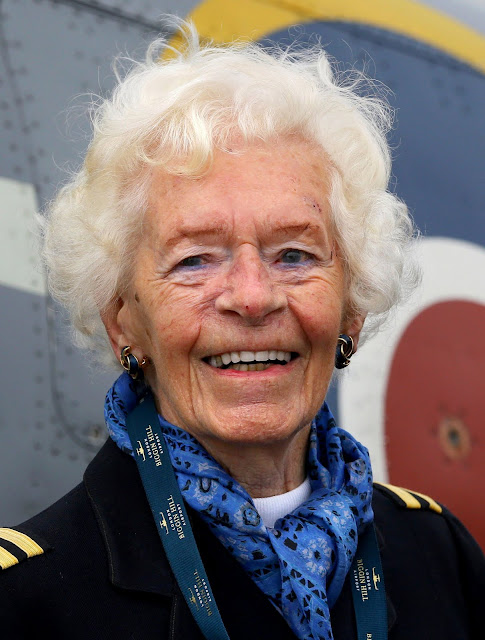By Ceylan Yeginsu
July 26, 2018
LONDON — Mary Ellis, a pioneering aviator and one of Britain’s last surviving World War II female pilots, who overcame public disapproval to fly hundreds of Spitfires and heavy bombers to the front lines, died on Wednesday at her home on the Isle of Wight. She was 101.
Her death was confirmed by the Royal Air Force.
Mrs. Ellis was one of the last two living members of the Air Transport Auxiliary, or A.T.A., which has since disbanded. She alone ferried 400 Spitfires and 76 other kinds of aircraft to airfields during the war.
She joined the A.T.A. in 1941, a year after Britain allowed women to fly military aircraft, but they were still prohibited from involvement in combat missions.
“Everybody was flabbergasted that a little girl like me could fly these big airplanes all by oneself,” Ms. Ellis said at a party to celebrate her 100th birthday.
They were among the first women in Britain to get equal pay; 168 women, including volunteers from the United States, served in the A.T.A., according to the BBC.
Mary Wilkins was born on Feb. 2, 1917, on a farm in Oxfordshire, west of London, to Charles and Ellen Wilkins, according to the autobiography “A Spitfire Girl,” written with Melody Foreman. She grew up close to the bases of the Royal Air Force as one of five siblings.
Ms. Ellis told the BBC that she became interested in airplanes “from almost the year dot.” When father paid a flying circus to take her on a joy ride, she said, it “sealed her fate forever.”
She took her first flying lesson when she was a teenager and flew for pleasure until 1940, after she heard a radio advertisement seeking female pilots to join the A.T.A.
“Sometimes, as her efficiently compiled Logbook of those years between 1941 and 1946 reveals, she could have up to four aircraft in a day to deliver, ranging from Spitfires to Tempests, Hudsons, or a twin-engine Airspeed Oxford,” Ms. Foreman wrote in an online post.
The decision to allow women to fly Spitfires and bombers during the war was met with widespread resistance in Britain.
“Women anxious to serve their country should take on work more befitting their sex instead of encroaching on a man’s occupation,” an editorial published in Aeroplane magazine in 1940 declared.
Ms. Ellis recalled in the BBC interview, “Girls flying airplanes was almost a sin at that time.”
But eventually the female aviators proved that they were up to the job, she said, and as a result they received a lot of attention.
“At that time we were called the ‘glamour girls.’ I don’t know why,” she said. “But there were always plenty of escorts around.”
In 1945, after the war ended, Ms. Ellis was invited to join the R.A.F. and became one of the first women to fly the Meteor jet fighter, according to Ms. Foreman.
She went on to work as a private pilot for a wealthy businessman, who bought Sandown Airport on the Isle of Wight, where Ms. Ellis was appointed manager in 1950.
She married a fellow pilot, Don Ellis, in 1961. The couple, who lived close to the Sandown Airport runway, had no children. He died in 2009.
Her death leaves Eleanor Wadsworth, who lives in Bury St. Edmunds, England, as the last surviving A.T.A. member.
During her service at the airport, which lasted until 1970, Ms. Ellis helped introduce passenger flights to and from the island to Europe. In recent years she had become a popular member of the Air Transport Auxiliary Association.
In January she received the Freedom of the Isle of Wight award for what the local council described as “heroic actions in delivering more than 1,000 aircraft to front-line units during World War II.”
Mrs. Ellis’s goddaughter, Clare Mosdell, a council cabinet member, described Ms. Ellis as “the last link to female pilots who did vital work in the fight against the Nazis and also against perceptions of what women could do.”
“Despite the danger and the attitudes of the time, Mary and her comrades came out triumphant in both,” she added.
About 15 female A.T.A. members were killed during World War II, according to the BBC.
In the autobiography, Ms. Ellis described flying her first Spitfire, on Oct. 15, 1942, which she called “a date and time etched in my memory.”
“I decide to pull back on the power to plus four boost and 2,400 r.p.m.,” she said, “and I fly away from the airfield at around 150 m.p.h. to the delight of an enthusiastic ground crew waving in celebration at my successful takeoff. I soon realize the ailerons are quite weighty but very responsive and the elevators refreshingly light in pitch.
“I look down from the neat cockpit and for a few moments enjoy the view below. I see fields, tiny random houses and then a cluster of buildings, a small village and the lanes to and from it. I listen to the thumping hum of a happy Merlin flexing its power in the sky where it belonged.
“But while my heart was completely fulfilled, my mind was busy in the cockpit of the fastest, most beautiful fighter aircraft in the world, as I was responsible for its safe journey to the R.A.F. pilots who needed it.”
A version of this article appears in print on July 30, 2018, on Page B7 of the New York edition with the headline: Mary Ellis, Who Flew British Spitfires During Second World War, Dies at 101. Order Reprints | Today’s Paper | Subscribe
•••••••••••••••••••••••••••••••••
BBC News is free. I suggest click the link.
BBC News - WW2 Spitfire pilot Mary Ellis from Isle of Wight turns 100
 |
| Mary Ellis joined the ATA in 1941 after hearing an advertisement on BBC radio |


No comments:
Post a Comment
Note: Only a member of this blog may post a comment.